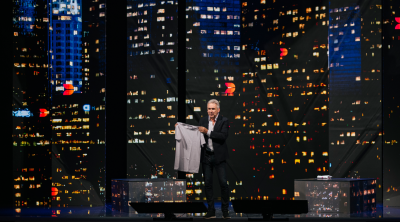Rohit Talwar, CEO of Fast Future, discusses long-term sustainability drivers and scenarios for a post-pandemic planet with Future
With the COP26 summit having to extend into an unscheduled overtime to secure a climate change deal – which underwhelmed many key stakeholders and smacked of compromise – it’s clear that even a “fragile win” for the planet’s future can be hard to predict.
The headwinds caused by an unstable global economy and a short-sighted approach by many nations seemingly more vested in protecting self-interests than the planet means forecasting long-term sustainability trends is not for the faint-hearted. Long-term sustainability strategies have always been susceptible to external forces – most notably a guarded protectionism of heavy industry from some of the largest countries and the unwieldy influence of big business. The Covid-19 pandemic, however, really was a bolt from the blue – destabilizing economies and triggering uncertainty for most nations. But how much impact did it have on sustainability trends?
“We were all pleasantly surprised that, when we had to go into lockdown, it had a very positive impact in the near term,” says futurist Rohit Talwar, CEO of Fast Future. “We weren’t going into our offices; we weren’t heating those buildings; we weren’t getting on planes. Ultimately, the pandemic had some positive impacts, particularly around energy consumption and the energy footprint of buildings. It challenged a lot of organizations because carbon footprints were slashed dramatically. We saw several big consulting firms commit to zero emissions by 2025, or 2030.”
The pandemic, says Talwar, forced the hand of big companies because, having seen some of the environmental benefits brought about by the pandemic, they could not go back to a higher overall environmental footprint. “Rather than people putting sustainability on the back foot, which had been a concern as we raced to recover revenues, what’s actually happened is a lot of people said, ‘How do we do both? How do we claw back the revenues and get back to 2019 levels of income, but also keep driving down our environmental footprint?’”
Many companies have since actively encouraged workers to continue working from home, meaning they don’t need to occupy so many large buildings, saving heating and electricity costs, but says Talwar, it has also been the catalyst for more affirmative action among employees. “There’s now an energy in the workforce to say, ‘We need to do something to address the adverse impact of climate change and our loss of biodiversity.’ People are being bombarded with this now and it’s very hard to ignore how serious the problem of sustainability is.”
“There’s now an energy in the workforce to say, ‘We need to do something to address the adverse impact of climate change and our loss of biodiversity.’ People are being bombarded with this now and it’s very hard to ignore how serious the problem of sustainability is”
Rohit Talwar
Positive impact down the supply chain
This is coupled, says Talwar, with a growth in focus on impact investing from investment funds, and sovereign wealth funds as they try to fulfil “a broader social remit”. Corporations are also putting pressure on their supply chains as a way of reducing their environmental footprint, increasingly putting into their contracts or calls for proposals, requirements about the environment and requests for statements of climate policy and plans to reduce an environmental footprint in the years ahead. “It’s becoming very widespread,” he says. “Sometimes it’s being applied without a huge amount of thought, but the energy is there.”
Events, such as COP26 are, according to Talwar, “helpful to a degree”, because they give focus to this movement. “It’s a useful lens through which to focus the attention of corporates, and to show that they’re on the side of the angels.” Another important aspect is that, with all the monitoring and reporting of sustainable development goals a growing realization that, previously, much of the data was either inaccurate or irrelevant. “The fallacy around carbon offsets is gradually having a hole blown through it,” says Talwar. “This idea that you can create a market and make money out of reducing carbon emissions just by trading credits – the marketplace won’t accept that now. We have to actually reduce our own emissions.”
The next normal
So, what does a post-pandemic landscape for meaningful sustainability initiatives look like – and what will be the key drivers? For Talwar, customer pressure, market pressure and brand pressure are all key to enforce change. “That will intensify with social media. Brands are under immense scrutiny. The pressure to drive down that footprint will be essential.”
“Brands are under immense scrutiny. The pressure to drive down that footprint will be essential”
Rohit Talwar
Transparency of how a brand operates will be very important, says Talwar, as will a growing focus on provenance and the environmental footprint of an entire supply chain. “Eventually, the capital markets and stock markets will start pricing your environmental performance into their assessment, mainly from the perspective of what business you could lose if you don’t get your act together.”
Talwar also predicts “a big shift” where market analysts will rank a company’s environmental footprint, placing an equal weighting on its past performance and its future potential as a business. “So, alongside profit and financials, we’ll see a ranking of ESG credentials, a commitment to serving the planet and an innovation pipeline for the future. Once [these rankings] have a more equal weighting, that will be an interesting turning point,” he says.
The sheer costs and resources required to retrofit a business to bring its emissions down to accommodate for this additional scrutiny will inevitably have a knock-on effect on prices. So, says Talwar, “The smarter people are getting in now, getting the best grants, and [sustainability] solutions at the lowest price, delivered faster.” Eventually he says, we will begin to see “mass boycotts” of firms that refuse to adjust their carbon footprints. “We’re going to see a lot of action in the next few years to move things forward, to bring forward our target dates, and to reward those who perform best in advancing the sustainability agenda.”
“We’re going to see a lot of action in the next few years to move things forward, to bring forward our target dates, and to reward those who perform best in advancing the sustainability agenda”
Rohit Talwar
Ultimately, says Talwar, it makes good business sense to act sustainably, for two reasons. “One is, it’s good to be an ethical and moral business, demonstrating corporate social responsibility – showing you are acting for a greater good. There’s an acceptance that we need to turn clever PR into real action. Secondly, it’s a wonderful recruitment message and motivator for people. It’s a real way of harnessing ideas and energy, helping employees feel proud because they’re working for a company that cares. Customers want this more and more – it’s another good thing to have in your marketing to show you’re hitting various environmental targets, or exceeding them, particularly if you’re one of the first few to get there. That’s a great marketing story.”
Cities of the future
As for wider society, sustainable cities of the future, predicts Talwar, will be increasingly car-free, sun-powered, and eco-centric. “This is about designing our cities for the real purposes they’re going to be used for. We’re going to use them less for office space and retail and we’re going to repurpose them around social activity.”
And these sustainable cities will depend on a constant stream of information to function, he says. “That’s where the Internet of Things comes in – to tell us how everything’s working, the environmental footprint, movement of traffic and emissions. We will put sensors on everything to give us a very clear picture of what’s going on. Then we can run our cities in a way that allows them to get smarter,” says Talwar.
“Public transport will get better. Inner cities will get much greener. We’ll put vertical farms on top of or up the walls of buildings. Multi-storey micro allotments will replace shops. Public sector administration buildings that consolidate activities – such as magistrates courts sharing spaces with schools or police stations – will also replace retailers. Town centers won’t die – but be repurposed. There’s a lot more we can do to make cities greener, more vibrant, more sustainable.”







